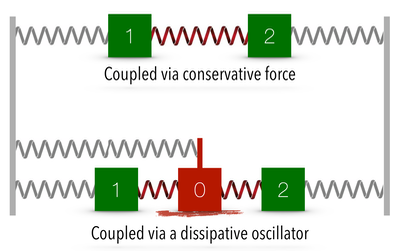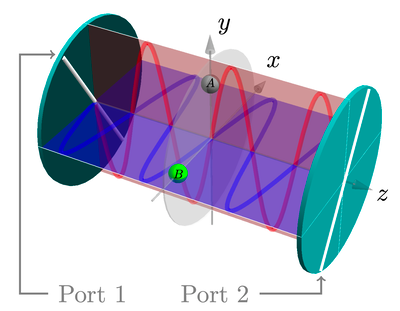This work started last October during a KITS workshop held in Beijing. During the workshop, Prof. Can-ming Hu from University of Manitoba in Canada reported a non-typical energy level crossing [1], the so-called level attraction, in a YIG-cavity system. The level attraction is very different from the typical repulsive anti-crossing whenenver two energy levels intersecting each other.
Such level attraction behavior is very similar to the two precessing ferromagnets coupled via spin-pumping and spin-transfer torque studied more than a decade ago by Prof. Yaroslav Tserkovnyak [2]. Therefore, Prof. Xiao proposed after Hu’s talk that what Prof. Hu had observed shares the same physics as that seen in the ferromagnetic systems, and gave a simple coupled harmonic oscillator analog of the situation.

The crucial thing here is that the coupling must be of dissipative nature, where thes spin pumping/spin-transfer torque happens to be. In a coupled harmonic oscillator case, the dissipative coupling can be realized by friction or viscous force or via a third oscillator with high dissipation (see the figure on the right).

To explain Hu’s experiment completely, it involves serious modeling and simulation to finally pin down what the third-party dissipative oscillator really is in the YIG-cavity system. After about half year of efforts, we are able to uncover that the dissipative mode in the YIG-cavity system is in fact the degenerate cavity mode of orthogaonal poalrizatioin which happens to have high dissipation because of the leakage through the opening ports.
The model is extended from semi-classical regime into quantum regime, and the non-Hermitian Hamiltonian for an effective 2-mode system is derived from a 3-mode system, which can nicely explain all observations in the experiment.
This work was a collaboration between Dr. Weichao Yu, Mr. Jiongjie Wang (a junior undergraduate student), and Dr. Huaiyang Yuan (from SUSTEC). The paper was published on Physical Review Letters (link) recently [3].
[1]. Harder, M. et al. Level Attraction Due to Dissipative Magnon-Photon Coupling. Phys. Rev. Lett. 121, 137203 (2018).
[2]. Tserkovnyak, Y., Brataas, A., Bauer, G. E. W. & Halperin, B. I. Nonlocal magnetization dynamics in ferromagnetic heterostructures. Rev. Mod. Phys. 77, 1375–47 (2005).
[3]. Yu, W., Wang, J., Yuan, H. Y. & Xiao, J. Prediction of Attractive Level Crossing via a Dissipative Mode. Phys. Rev. Lett. 123, 227201 (2019).
